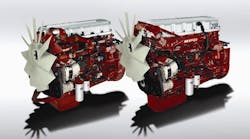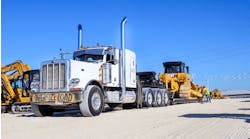A soon-to-be released study compiled by global consulting firm Frost & Sullivan projects that the average displacement for Class 8 truck engines in the U.S. is going to shrink anywhere from 2% to 3% by 2018 as OEMs and fleets alike seek ways to improve fuel economy and payload capacity simultaneously for tractor trailers.
However, Sandeep Kar, global director of commercial vehicle research for Frost & Sullivan, stressed that the power density of Class 8 engines will actually increase significantly – some 6% to 8% – over the next six years even as they shrink in size; providing in many cases an opportunity, in his words, for fleets “to have their cake and eat it too.”
“What we’re finding is that criteria such as total cost of operation [TCO] are becoming more important to fleets in the face of rising fuel prices,” Kar told Fleet Owner. “The upfront purchase price and total lifecycle costs of smaller engines are lower, while fuel economy is better.”
The key, however, is that power isn’t necessarily lost in the transition to smaller engines anymore, he explained, meaning fleets don’t necessarily have to sacrifice performance to gain a better TCO position. And it’s the ability to retain power density that’s getting more fleets to consider “downsizing” their truck engines, Kar said.
Based on its research, Frost & Sullivan projects that average Class 8 truck engine displacement will fall to between 13.4 and 13.7 liters by 2018, down from an average range of 13.7 to 14.1 liters back in 2011. Conversely, average horsepower will climb to between 425 and 540 by 2018, compared to a range of 400 to 520 back in 2011. Torque will also jump as well, increasing to between 1,300 and 1,750 ft.-lbs. on average compared to between 1,250 and 1,650 ft.-lbs. averaged in 2011.
A variety of technologies – such as improved fuel injection systems and turbocharger designs for starters – are helping engines shrink in size while pumping out more power, with more such improvements on the way, according to Kar, in the form of waste heat recovery systems among others.
The influence of natural gas and “hybridization” will also be factors in this engine displacement shift as well, as OEMs seeks ways to comply with stringent greenhouse gas (GHG) rules set to go into effect between 2014 and 2018, while fleets continue efforts to reduce impact of high diesel prices on their bottom lines.
As a result of all those many factors, by 2018, Frost & Sullivan predicts the makeup of the Class 8 engine market be very different compared to last year.
In 2011, the firm said 14 to 16 liter engines comprised 56% of the Class 8 market, with 12 to 14 liter engines making up 35% and 11 to 12 liter models at 3% market share.
By 2018, however, Frost & Sullivan expects 14 to 16 liter market share to shrink down to 42%, while 12 to 14 liter models jump to 40% market share, followed by a steep rise market share for 12 to 14 liter engines to 15%.
Eleven liter and smaller engines will also be used more widely by fleets, especially those operating “Baby 8” or natural gas-powered trucks, and thus claim 2% share of the Class 8 engine market in 2018.
The trend towards engine downsizing will also result in a shift away from third party engine makers to models provided by vertically integrated OEMs, Frost & Sullivan projects.
“Remember, the real game here for truck OEMs is the move to global platforms – and outside the U.S., smaller engine displacement sizes dominate,” Kar said. “Those smaller engines offer better fuel economy and payload for fleets, but also better margins for the OEMs. That has to be considered in this shift as well.”
Yet he stressed, however, that the long haul Class 8 segment will continue to remain dominated by 14 to 16 liter engines as those models offer the best power rating and optimized performance metrics. "Also, sales of those larger-displacement engines will be aided by a strong used truck market, where 15 liter engines in particular are attracting higher valuations," Kar noted.
That being said, though, he pointed out that length of hauls will continue to shrink in future; and that will aid in the proliferation of downsized engines in Class 8 segment.



